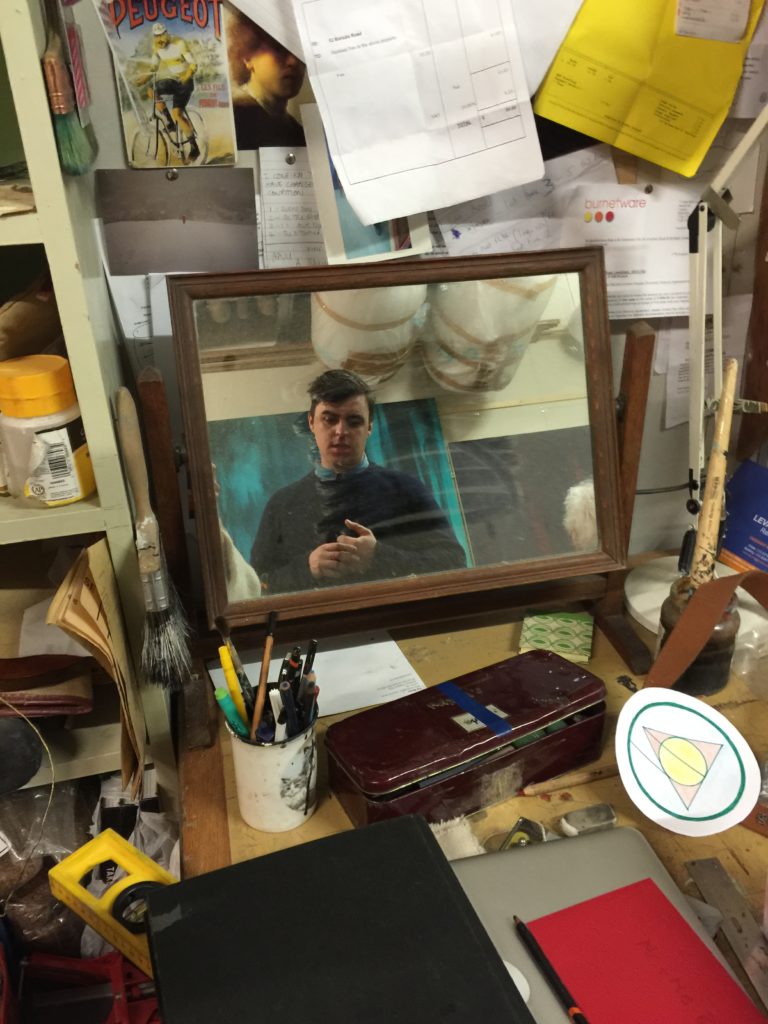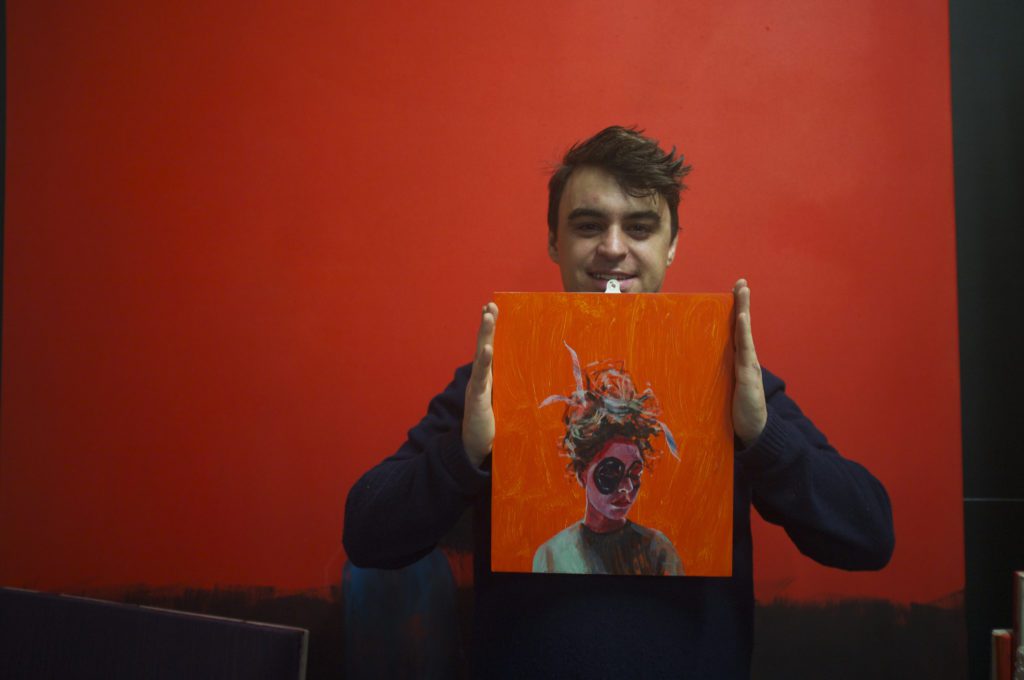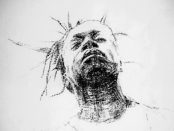Bartholomew Beal — Reflections on Contemporary Symbolism
The Europe-wide symbolist movement of the late nineteenth and earliest twentieth century never counted for much in Britain. Its major figures, at least insofar as the visual arts are concerned, were mostly of French, Belgian or Russian origin. Names such as Odilon Redon, Pierre Puvis de Chavannes, Félicien Rops and Jan Toorop populated the list. Plus those of the Russians Mikhail Vrubel and Nicolas Roerich. Also present is that of the great Norwegian painter Edvard Munch.
Though there were indeed British participants in the symbolist movement, the only British practitioner of the visual arts allied to it, and who also counted for something internationally, was the printmaker and illustrator Aubrey Beardsley. Beardsley, in a meteoric career that lasted only a few years—he died of tuberculosis at the age of 25—produced images that influenced both Japanese art (from which he borrowed reciprocally) and also that of pre-revolutionary Russia. He was a disruptor and creator of scandals, and as a large retrospective at Tate Modern goes to some lengths to prove, his influence has been intermittently felt in popular art forms in Britain up to the present day.

There are also one or two ‘fine art’ descendants of the symbolist movement to be found in contemporary British art. Its impact can still be seen in the work of twenty-first century British artists who work in relatively conventional forms, such as painting. For example, in that of Billy Childish, one of the founders of the worldwide stuckist movement, which now has members in more than 60 different countries.
Childish left stuckism behind almost as soon as the movement came into being, and no longer wishes to be associated with it. He makes work that is internationally exhibited, though still largely ignored by official British agencies. What he produces shows clear influence from the work of Munch.
Another example, much less well known than he should be, is the painter Bartholomew Beal, who died on Boxing Day, 2019, of a brain tumour. He was 30, just a few years older than Beardsley. When one compares Beal’s work to Beardsley’s, one notes that he is much less radical, in terms of his response to the society he inhabits, than Beardsley was in his day. In the latter’s work there is a deliberate element of provocation; images of men with enormous erect penises, for example. This is absent from what Beal produced.
Yet there are also parallels. While neither Beal nor Beckett claimed surrealism as an influence on their work, there is a disjointed, eccentric, absurdist aspect of their work which ploughs similar furrows to the exquisite corpses games used by the movement in an approach to unlocking the imagery of the subconscious mind. Both artists were inspired by literature; Beardsley first by Oscar Wilde’s Salome (1893), then by Thomas Malory’s Le Morte d’Arthur (1485). Beardsley also took inspiration from the bawdy Ancient Greek comedy Lysistrata (411 BC) and Alexander Pope’s “Rape of the Lock” (1712). Often his purpose, in making illustrations, seemed to be to discombobulate the audience. His illustrations in Salome, the work with which he launched his career and which immediately made his reputation, offer a number of sardonic caricatures of Wilde, the author of the actual text. There are also images that have little to do with anything depicted in the work.

Some of Beal’s sources of inspiration, used for two major shows managed by Isis Phoenix Arts in collaboration with the FAS Bond Street in London, were T. S. Eliot’s poem “The Waste Land” (1922), and Shakespeare’s tragedy, King Lear. Thus far, in his use of literary source material, he showed himself to be a disciple of his late Victorian predecessor, Wilde. However, his relationship with the material he chose is far more relaxed and fluent. The techniques he used, for paintings made in full colour, enabled him to make images that illustrate the processes of creative thinking, not simply a take-it-or-leave-it final result, which Beardsley’s graphic processes, images made for reproduction, inevitably demanded.
Where Beardsley set out to tease and to challenge, Beal offered a meditation about his chosen texts, and his own emotional reactions to them.
I would like to quote something here that I wrote in a brief catalogue essay for the first of these two Fine Art Society exhibitions:
‘Let’s enumerate some of the things that make [Beal’s] work—for me at least—particularly interesting. First, very obviously, there is the emphasis on the visual, the pleasure of the eye. In contemporary circumstances, artistic developments seem to offer a rhythmic oscillation between two different poles: what is visual, often to the apparent exclusion of any kind of intellectual content; and what is conceptual—a mere diagram or statement, intended to make us think rather than actually enjoy what we are looking at. There has also, increasingly, been an oscillation between what is material—things made of stuff (though often not of the kind of stuff we expect an artwork to me made of)—and the aggressively immaterial.’
To this I added:
‘What is very contemporary about these paintings is their use of the idea of the non-finito. Beal speaks of his “favourite treatment of paint siting decided figures next to elements of painting that are unfinished or ambivalent.” Essentially the spectator is asked to look at them, not as things already frozen in time, but as statements that are still in the process of evolving, capable of morphing into another form, or series of forms, the instant one looks away from them.’
The thought becomes particularly poignant when one considers that the paintings live on, while the artist is now dead.
In fact, the kind of paintings that Beal made now look particularly new and relevant, because of a growing sense of disillusion in the world of contemporary art, when confronted with the other kinds of visual art that are currently on offer. Tate Modern, for example, has, at the time of writing, just opened a new exhibition of work by Andy Warhol, who died in 1987. At the peak of his career, Warhol’s work represented the triumph of pop art, and with it the advent of a new set of values in art-making.
In her review of the show, Rachel Campbell-Johnson, art critic in residence at the Times, notes that: ‘In terms of his influence Warhol is probably the most important artist of the past half-century.’ This doesn’t mean, however, that she feels much empathy for what Warhol stood for: ‘Art production values are changing. Factory-style studios are fast disappearing… Artists are turning away from industrial production… The tactile, the handmade and the low-tech are in mode.’ What she prefers are ‘pieces that serve a purpose and deliver a message’. Campbell-Johnson cites, as a worthy example of this, the work of the architectural collective Assemble, who (she claims) won the 2018 Turner Prize ‘with a project that set out to improve an urban community’. (They were in fact short-listed, but didn’t win. The Turner, that year, was won by Charlotte Prodger, a Scottish artist who makes dinky little videos on her iPhone. But the mistake is informative.)
What the cultural establishment in Britain now longs for is a revival of quasi-Victorian values, where the artists who are in good standing with official agencies, notably the Arts Council and the various Tate galleries, are out there providing templates of social virtue, while at the same time making sure that their audience knows that this is what they are aiming to do. The war cry is: ‘Oh look at me; what a good little kitty I am!’
Beal had no interest in their crusade for social improvement, and none at all in soliciting merit badges for doing so. Yet, unlike Beardsley, who openly challenged Victorian values yet seemed to take little interest beyond that in exploring the image of the self, there is a constant note of questioning in his art.
This was already evident in his Saint Mondays show, exhibited in 2013 at the Derby Museum and Art Gallery, as the winner of the fifth Jonathan Vickers Fine Art Award. In a prefatory note Beal wrote: ‘Just as Joseph Wright [of Derby] commemorated the principal figures within the Industrial Revolution, which re-shaped the world, I chose my eccentric figures from folk music, poetry, old family archives and conversation. It was these people who defined the John Vickers theme: “A sense of place.”’
The catalogue for that show offers an illustration of a painting called You Exaggerate, facing a brief quote from Samuel Beckett’s play Endgame (1957). The quote begins with Clov’s line: ‘Oh, by the way, your story?’ and (not unexpectedly, since this is a text by Beckett) goes nowhere.
You Exaggerate shows a scrawny white-bearded man, arms raised, torso bare, standing behind a square plinth that conceals the rest of his figure. So much so that his legs may not in fact exist. Attached to the fingers of one hand by a dangling string is a plumb bob. Attached, in the same way to the fingers of the other hand, is an apple, or maybe some other fruit or root vegetable. The floor is a checkerboard of black and red squares. It is an extraordinarily eloquent, yet desolate image.
Another painting in the Derby show, a work entitled Alice in the Bacon Box, commemorated an elderly resident of Long Easton, on the outskirts of Derby, who between 1891 and 1911 lived in a bacon box. She is a close sister of the male figure portrayed in You Exaggerate.
As one looks through the images that Beal produced, one notes that he seldom chose to depict figures who could be considered members of his own generation or anything close to it. This preference seemed to strengthen as his work progressed. If one looks, for example, through the catalogue of his second show in 2016 managed by Isis Phoenix Arts in collaboration with the FAS Bond Street in London, one notes not only the title of the exhibition—This Great Stage of Fools, borrowed from King Lear—but also the figure of the aged king, standing with arms flung wide, on the cover of the catalogue.
Another theme, also linked to the text of Lear, is that of the Fool, the truth-teller who comments on the tragic narrative. Sometimes this Fool is presented not as a living figure, but as a puppet, a head without a body, on a stick. In one image, The Fool’s Marotte, it is the bearded king himself who appears mounted on the stick, a fringe of bells edging his garment where it abruptly ends. Subversion and carnivalesque role-reversal combine with the dreamworld illogic of surrealism to present a fudging of archetypes. Ultimately, there is little to distinguish between fool and king; each is superseded by his role, reduced to a talismanic puppet. It is the signifiers of their roles which endure, not the individual wearing them.
Looking at these images one can easily guess that, even if he didn’t know the fate that lay in wait for him in the near future, Beal wasn’t by temperament an optimist. All of his work, first to last, resonates with a feeling of his destiny.
What one also senses, however, is the power of his image-making. He creates a world, seen in fragments, but with a powerful inner coherence. Like a number of British artists before him, he can be described as literary, in the sense that he often uses the visual art he creates to offer a commentary on existing texts. Yet he never allows these texts to overwhelm his imagination. He inhabits the text fully and makes it a vehicle for his own imagination.
Beal died too early, and it is impossible to know what he might have achieved, had he lived a longer life. What one can say is that he is part of the now long succession of British artists who had something unique to say about the world they lived in and, yes, about the society they inhabited. The do-goody commentators of the present moment are likely to be quickly forgotten. There is not enough in their work to feed the spectator’s imagination.
Bartholomew Beal 24/8/1989 – 26/12/2019
References
Campbell-Johnston, R 2020, ‘Andy Warhol review — enjoyable, but time to consign him to the history books’, The Times, 10 March,
Biography.
Bartholomew Beal (Barley to his friends) graduated with a BA in fine art painting from Wimbledon College of Art in 2012 with a 1st class degree. Jason Colchin-Carter, founder of Isis Phoenix Arts, saw his work for the first time on June 15 2012 at Wimbledon College of Art Graduate Show’s Private View where Beal’s work sold out. Colchin-Carter was able to see at first hand and understand the obvious talent demonstrated in his work. ‘Barley was exceptionally impressive being able to speak very lucidly about his work and ideas, his love of language, literature, and poetry’. As a result, a working relationship of management and representation developed that lasted to 2017. Beal entered and won the Jonathan Vickers Residency at the end of the Olympiad summer—the UK’s biggest financial award residency in excess of £30k for a full year with studio, materials and a small but excellent support team. During the exciting ensuing growth period many exhibitions were held by Isis Phoenix Arts. These included Biscuit. I’ve kept you half (Mall Gallery 2013), Saint Mondays (Vickers residency; Art Gallery, Derby & Derby Museum 2013), collaborations with IP Arts and FAS Bond Street for two solo exhibitions, namely, A heap of broken images (2014) and This great stage of folks (2016). Beal was the youngest artist ever to exhibit at the FAS which at the time was the oldest gallery in the UK, being established for over 175 years. Isis Phoenix Arts found homes for his work in some of the more prominent private collections in the UK, including Mr Levedev’s collection, international collectors, and in corporate collections. Numerous group shows were held, as well as three art fairs ‘Art15’, ‘Art14’, and Art Miami 2015. Beal’s practice involved painting works stimulated by literature, particularly plays and poems, drawing upon themes from T. S. Eliot, William Shakespeare, Seamus Heaney, and Eugène Ionesco.
Beal passed on Boxing Day 2019, aged 30. His legacy is an incredible body of work from 2012 onwards, and an outstanding inspiration to his contemporaries. Isis Phoenix Arts and Jason Colchin-Carter took great pleasure in achieving all this with and for him.
For all enquiries please contact Isis Phoenix Arts on office@isisphoenixarts.com
Further links:
http://www.isisphoenixarts.com/project/bartholomew-beal/
http://www.isisphoenixarts.com/exhibitions/
http://www.isisphoenixarts.com/project/bartholomew-beal/
John Edward McKenzie Lucie-Smith (born 27 February 1933), known as Edward Lucie-Smith, is an English writer, poet, art critic, curator and broadcaster.




















